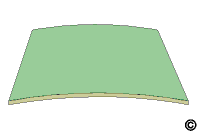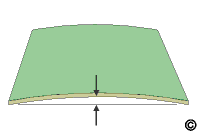No. 3.2
Bow and Twist Repair
OUTLINE
This method is used to eliminate, or reduce the bow and twist, or warping of circuit
boards. The warping is removed by controlled heating and cooling of the circuit board
while under restraint.
CAUTION
This repair method is most suitable for FR-4, GE or GF substrate base materials
having glass transition temperatures below 125°C (257°F).
CAUTION
This process uses high temperatures. Some components may be sensitive to high
temperature.
NOTE
Bow and twist should not be repaired unless sighted as a defect
TOOLS & MATERIALS
Base Plate
Caliper or Pin Gauges
Oven
Restraint Bars
Restraint Clamps
PROCEDURE
- Check the deflection to determine if rework is needed. See Figure 1
NOTE
Bow and twist after soldering shall not exceed 1.5% for through-hole circuit boards
and .75% for surface mount circuit boards. The bow and twist shall not be sufficient
to cause difficulties during placement, soldering and testing operations. Before
dispositioning circuit boards with bow and twist as scrap, keep in mind how the circuit
board is mounted in its final destination. Keep in mind "form, fit and
function" without jeopardizing reliability.
- Place the restraint bars along the edges that require rework. (See Figure
2).
CAUTION
Components or parts that will interfere with the restraint bars should be
removed.
- If the circuit board is warped along more than one edge or more than one plane,
clamp the entire circuit board to the base plate
- Place the circuit board, restraint bars and base plate into the oven. Bake for 1
hour at 125°C (257°F).
- Remove from the oven and allow to cool to room temperature.
- Remove restraint bars.
- Check the edges deflection using a caliper or pin gauges.
EVALUATION
- Check for marks or damage along edges.
- Electrical tests as applicable.
|
|
|
Solutions Across the Board
TM
|
|
|
|
Product Class: R/W
Skill Level: Intermediate
Conformance Level: High
Revision: D
Revision Date: Jul 7, 2000
Repair Service Charge

Bow and Twist

Figure 1: Check edge deflection for maximum warp.

Figure 2: Clamp restraint bars to edge needing rework.
|
|
|
